Maybe modern cosmology is based on Kepler’s law of planetary motion. But, it was the Copernican model: The Original Sun-Centered Solar System that caused the paradigm shift in the field of physics and astronomy, by claiming that the sun is the center of the solar system (Universe), not earth.
With this in mind, the Copernican Model is also known as the slayer of the Earth-Centered Universe. This heliocentric model of the universe was developed by Nicolaus Copernicus (1473 -1543 AD), therefore, also known as the Copernican system.
Well, if you don’t know the geocentric model of the universe stood on its four grand pillars, on which it stayed in the hearts of astronomers for more than 15 centuries. These pillars were:
- Earth is the center of the universe.
- Apart from the earth, everything is made of weightless & incorruptible substances i.e Aether.
- Everything in this universe revolves around the earth in concentric circular spheres.
- Stellar Parallax does not exist. Therefore, Earth is immovable.
As we will go ahead in this case study, you will see how these four pillars of the Aristotelian-Ptolemaic Universe were step by step broken, at first, by Copernicus, then Galileo, then Kepler (of course, with Newton’s help), and then by Friedrich Bessel’s observation of stellar parallax.
Let’s start this case study and try to understand the whole case scenario. One more thing, if you like this article, don’t forget to share it with your friends and colleagues. Let’s Dive in…!!!
Editor’s Choice: 6 Newton’s First Law of Motion Examples in our Daily Life
Copernican Model of the Universe
Here is the list of topics, I shall be discussing in this article.
- Aristotelian-Ptolemaic Model: The Earth-Centered Universe
- Demise of Earth-Centered Universe: BUT WHY?
- Copernican Model: The Sun-Centered Universe
- Heliocentrism (Copernican Model) vs Geocentrism
- Copernican Revolution: Coffin of Earth-Centered Universe
- Copernican Model: First Nail in the Coffin
- Galileo’s Telescope: Second Nail in the Coffin
- Kepler’s Law: Third Nail in the Coffin
- Stellar Parallax: Fourth and Final Nail in the Coffin
- Conclusion
Aristotelian-Ptolemaic Model: The Earth-Centered Universe

Before starting things off, I would like to clear some air between the Aristotelian Model and the Ptolemaic Model. Well, in my view, both of them are the same (okay, almost).
The only difference between them is that the Aristotelian universe defines the physical aspects (physics) of the earth-centered universe.
On the other hand, the Ptolemaic Model outlines the mathematical solutions behind the working of the geocentric model of the universe.
Therefore, when you combine both aspects of reality i.e physics and mathematics, this earth-centered universe becomes an Aristotelian-Ptolemaic Universe.
In the Earth-Centered Universe, the order of spheres from the Earth outward is as follow:
What is Geocentrism Anyway?
In the Aristotelian universe, the earth is the center of the universe, and all the planets, stars, sun, and all heavenly bodies revolve around the Earth.
In his treatise On The Heavens, Aristotle (384 – 322 BC) proposed the physical aspects of the universe i.e earth is eternally unmoved. And, everything else revolves around it in concentric spheres.
Later, Ptolemy (100 – 170 AD) in his treatise Amalgest, solidified the idea of Aristotle by providing the mathematical solutions for the Earth-centered Universe.
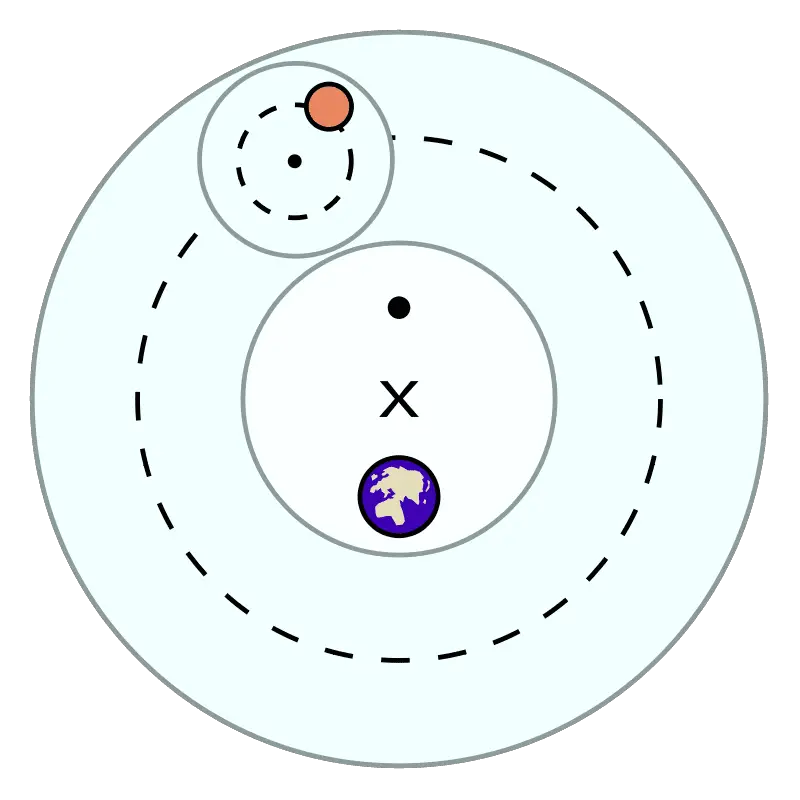
Ptolemy argued that each planet is supposed to be moved by a system of two distinct spheres. An epicycle i.e a small circle in which a planet moves.
Moreover, a deferent i.e a larger circle in which an epicycle moves. Not to mention, the Deferent is a circle whose center point is removed from the Earth. See the above figure for a proper understanding.
On one hand, Ptolemy used the concept of deferent to explain the variations in the lengths of the seasons. On the other hand, he used the concept of epicycles to explain the retrograde motion of the planets.
Retrograde motion is a type of motion in which a planet appears to be slowing down to stand still, then moving backward for a time being, and then again moving in the forward direction.
The demise of Earth-Centered Universe: BUT WHY?
From the time of its inception, the Aristotelian-Ptolemaic Model was widely accepted as the Cosmological model of the universe. I mean, this model ruled the heart of all physicists and astronomers for more than 15 centuries.
First, for the astronomers of those times, the sun appears to be revolving around the earth once per day. Hence, making day and night on earth.
Second, from the perspective of the Earthlings, Earth seemed to be unmoving. Therefore, for them, the geocentric theory was factually correct.
Must read, Geocentrism vs Heliocentrism in Tabular Form
To put it differently, whatever observations ancient astronomers were getting were in direct relation to the Earth-Centered Universe.
That’s why the question pops out, that if everything was going great. Then, what led to the demise of the Aristotelian-Ptolemaic Model of the universe?
Retrograde Motion of Mars
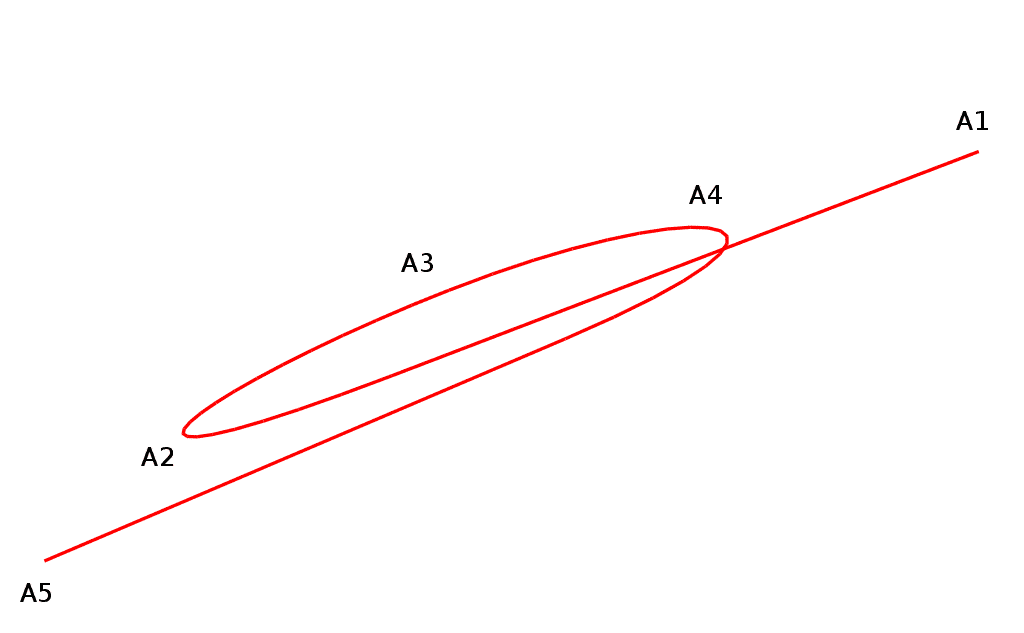
It is not a hidden fact, that the Mars retrograde issue had been known from the time of Ptolemy himself. Although, he used the concept of epicycle and Deferent to explain the retrograde motion of the planets.
Yet, he was not able to give an account for the unusual retrograde motion of mars. I mean, the way sometimes the retrograde loop of mars becomes smaller, sometimes even larger than expected.
To fix this mar’s retrograde issue, he even modified his epicycles and deferent sphere model. Unfortunately, all his efforts were in vain.
Other Astronomical Errors

Not to mention, the sole reason for the demise of the Earth-centered universe was the unusual retrograde motion of the Planets. Yet, there were some astronomical errors too that played their respective roles. I mean, there came a time when the astronomical table developed by the Geocentric model became rusty.
In other words, the predictions based on the Ptolemaic Model for astronomical events such as eclipses or Equinoxes (like spring or Autumnal Equinox) were no longer accurate to their respective date.
As a result, astronomers started to realize that the time has come for a more accurate model for the correct predictions of all the upcoming astronomical events.
Copernicus Model: The Sun-Centered Universe
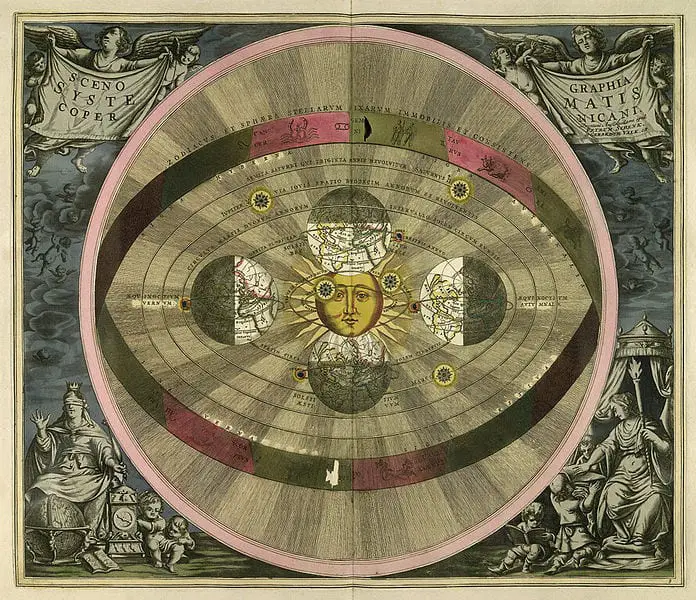
Nicolaus Copernicus in his book On the Revolutions of the Celestial Orbs proposed that the sun is the center of the solar system, not earth. Therefore, all the planets, including earth revolve around the sun.
In the Sun-Centered Solar system, the order of spheres from the Sun outward is as follow:
- Mercury
- Venus
- Earth
- Moon
- Mars
- Jupiter
- Saturn
- Fixed Stars
- So on.
To replace the Earth-Centered Solar System with the Sun-Centered Solar System, Copernicus proposed the following postulates:
- Earth is not the center of the universe (solar system).
- Earth is not stationary. On the contrary, it has three distinct motions. A daily rotation on its axis – making day and night on earth. An annual revolution around the sun, making a year on earth. And, an annual tilting of its axis is the reason for seasons on earth.
- The stars are Fixed in their spheres. Therefore, their apparent daily motion is caused by the daily rotation of the Earth.
- The distance between the Earth to the Sun is small compared to the distance between the Sun to fixed stars.
- Retrograde motion (especially Mars) can be easily explained with the help of Earth’s orbital motion.
- All planets move in a circular motion around the sun. (Just like the Earth-Centered Universe, but around the Sun, not Earth).
A Special Note
Well, maybe the Copernican model of the solar system is the bona fide slayer of the Earth-Centered Universe. But, that doesn’t mean the idea of heliocentrism was not known to ancient physicists and Astronomers. I mean, even ancient physicists and astronomers sometimes used to toy with the idea of the Heliocentric Universe.
For example, Archimedes, in his book Sand-Reckoner used the idea of Aristarchus of Samos to question the then-widely used Aristotelian-Ptolemaic Model of the universe. Yes, the Great Archimedes: a man who gave the idea of Buoyancy.
Aristarchus of Samos’s Heliocentric Model

It’s a well-known fact, that Aristarchus of Samos (310-230 BC) was the contemporary of the great Aristotle. He was also the greatest critic of the Aristotelian Universe model.
He is also recognized as the first person to present the heliocentric theory of the universe. That’s why Copernicus himself attributed his Copernican System to Aristarchus of Samos.
Unfortunately, the reference to Aristarchus was deleted just before the publication of On the Revolutions of the Celestial Orbs.
As Copernicus describes:
Philolaus believed in the mobility of the earth, and some even say that Aristarchus of Samos was of that opinion – Nicolaus Copernicus.
However, as time went ahead, most of the work of Aristarchus was lost. In particular, some people even argue that maybe due to the influence of Aristotle and Ptolemy of course, he became an unsung hero.
Heliocentrism vs Geocentrism
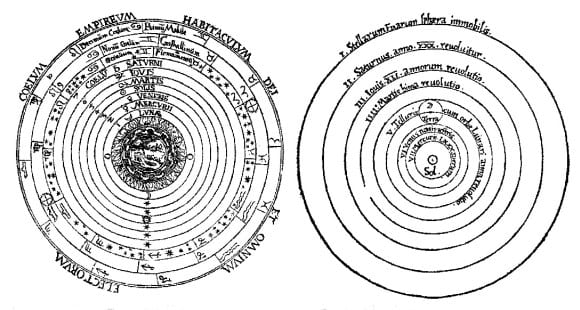
To give you a clear picture, I am mentioning some of the actual differences between the geocentric and heliocentric (Copernican system) theories. Let’s dive in.
- In the Copernicus Model of the Universe, Sun is the center of the solar system (Universe). While, on the other hand, in the Earth-Centered Universe, Earth is the center of the solar system (Universe).
- According to the Copernican Model, Earth is moving around. While according to the geocentric theory, Earth is immovable i.e stationary.
- In the Copernican Model, Earth and all the other planets revolve around the Sun. On the other hand, in the Earth-Centered Universe, Sun and all the planets revolve around the Earth
- In both of the cosmological systems, planets revolve in Circular Motion around the central object. Not to mention, the circular motion of planets around the sun also became the sole reason for the demise of the Copernican system.
- Copernican Model used the concept of Earth’s orbital motion to explain the retrograde motion of the Planets. While, on the other hand, the Aristotelian-Ptolemaic Model used the concept of epicycles to explain the retrograde motion of the planets.
Copernican Revolution: Coffin of Earth-Centered Universe

To seal a coffin, what you need is four nails (okay, at least four nails). Such was the case of the Earth-Centered Universe.
See, the Aristotelian-Ptolemaic Model was standing on its four pillars. Therefore, if you want to replace the geocentric model with the heliocentric one, you have to break all the pillars of the Earth-Centered Universe. This is what the Copernican revolution did. These Four Pillars were:
- Earth is the center of the universe.
- Apart from the earth, everything in this cosmos is made up of weightless and incorruptible (unchangeable) substances i.e Aether.
- Everything in this universe revolves around the Earth in concentric circular spheres.
- In reality, if Earth is revolving around the sun. Then, as a result, there has to be the observation of stellar parallax, which was simply not possible at that time. Hence, Earth is immovable.
Let’s see how the Copernican Revolution step by step broke each and every pillar of the Earth-Centered Universe. Hence, sealing the coffin of the Aristotelian-Ptolemaic Model of the universe.
Copernican Model of the Universe: First Nail in the Coffin
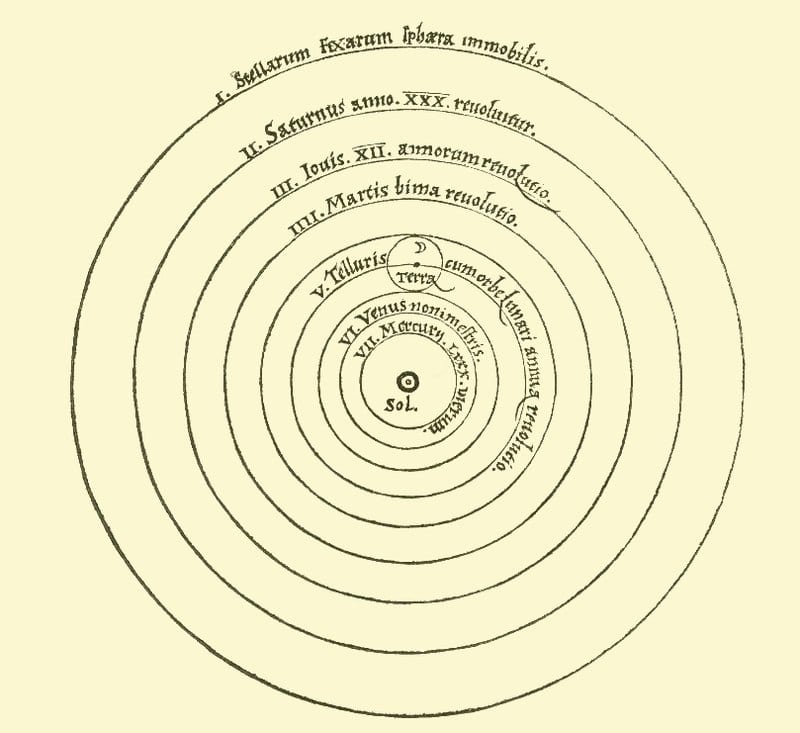
I won’t be explaining this part. You know the obvious reason behind it. I have already given you a brief review of the Copernican Model.
I mean, how Copernicus published his revolutionary idea in the year 1543 (the year of his death), therefore, broke the first pillar of the Earth-Centered Universe.
The idea that the Sun is the center of the solar system, not earth put the first nail in the coffin of the Geocentric model of the universe. Well, that’s why I said the Copernican model is the slayer of the Earth-Centered Universe.
Special Note: In this article, I could have explained how Copernicus visualized the concept of the heliocentric model. Or, the people who helped him. Or, what kinds of problems he had to face because of his unusual model of the universe.
But, certainly, I didn’t. Simply because I do not want to go into the historical time. I thought, maybe I could make it more compelling from the physical point of view, rather than indulging myself in being a history teacher.
Galileo’s Telescope: Second Nail in the Coffin

The second Pillar of the Earth-Centered Universe was finally broken by Galileo’s Scientific Revolution of the telescope.
The second pillar states that apart from earth, everything in this cosmos is made from a weightless substance called Aether.
Galileo with his telescopic discoveries observed the dark spots on the moon. By that, he proclaimed that the moon is entirely not smooth.
On the contrary, the moon has large craters and mountains, directly contradicting Aristotle’s hypothesis of the incorruptible perfect smooth moon.
In other words, Galileo’s investigation of the heavens allowed him to relate the moon’s imperfections with those seen on the earth’s surface.
Check out, The moon is moving away from earth, BUT WHY?
He argued that neither Earth nor any celestial objects are unique i.e made of Aether. All celestial objects including earth are made from Earth-like materials. As Galileo describes:
A perfectly smooth Moon would reflect light unevenly like a shiny billiard ball, so that the edges of the moon’s disk would have a different brightness than the point where a tangent plane reflects sunlight directly to the eye. A rough moon reflects in all directions equally, leading to a disk of approximately equal brightness which is what is observed – Galileo Galilei
With that, he broke the second pillar of the Earth-Centered Universe. In other words, the idea that neither earth nor any celestial objects are made of Aether put the second nail in the coffin of the Geocentric model of the universe.
Other Discoveries
Apart from discovering the dark spots on the moon, Galileo (1564-1642 AD) also discovered the moons of Jupiter and the different phases of Venus, just like the earth’s moon.
With his discoveries of Jupiter’s moon and Venus’s phases, Galileo sparked a great debate among the astronomer of that time.
Moreover, based on his discoveries, he argued that the moons of Jupiter orbit around Jupiter, not earth. Similarly, with the phases of Venus, he argued that venus indeed revolves around the sun, not earth.
Must read, Hence, That’s How Was The Moon Formed…!!!
In other words, with all his arguments, he theoretically questioned the fourth pillar of the Earth-Centered Universe i.e Earth is immovable.
Unfortunately, he couldn’t prove it. Because there has to be the observation of stellar parallax, which he couldn’t provide.
Kepler’s Law: Third Nail in the Coffin

Just like Aristotle and Aristarchus, Galileo and Johannes Kepler (1571 – 1630 AD) were contemporary to each other. On the contrary, unlike Aristarchus and Aristotle, they both had a similar view of the cosmos.
In other words, they both openly supported the idea of the Copernican model of the solar system.
Although, Kepler openly supported the Copernican idea. Yet, there were some ideological differences between them, which in fact, later paved the way for the third nail in the coffin of the Geocentric model of the universe.
Copernicus, on one hand, broke the first pillar of the Earth-Centered Universe. On the other hand, he retained the idea of the uniform circular motion of celestial bodies around the central object.
As a consequence, the Copernican system drastically failed to explain why planets orbit around the sun at different speeds at different locations.
Kepler, therefore, by replacing the circular orbits with elliptical ones, of course, with the help of Tycho Brahe’s Work, showed how planets speed up at certain points in their orbits and slowed down at others.
Newton’s Intervention
Even after Kepler’s argument that orbits should be elliptical, rather than the orthodoxal circular ones, some astronomers were still reluctant to identify themselves as being Copernicans.
Later, with Issac Newton’s intervention, astronomers soon started to identify themselves as being Copernicans rather than being Geocentrist.
In 1687, Newton (1643 – 1727 AD) showed that Kepler’s law of planetary motion is a direct consequence of Newton’s Laws of Universal Gravitation.
As a consequence, putting further weight on Kepler’s idea, and, of course, proving that the third pillar of the Earth-Centered Universe was neither correct nor viable.
Therefore, I can conclude that with Newton’s help, Kepler put the third nail in the coffin of the Geocentric model of the universe.
Editor’s Choice: Newton’s 2nd Law of Motion Examples – Top 6
Stellar Parallax: Fourth and Final Nail in the Coffin
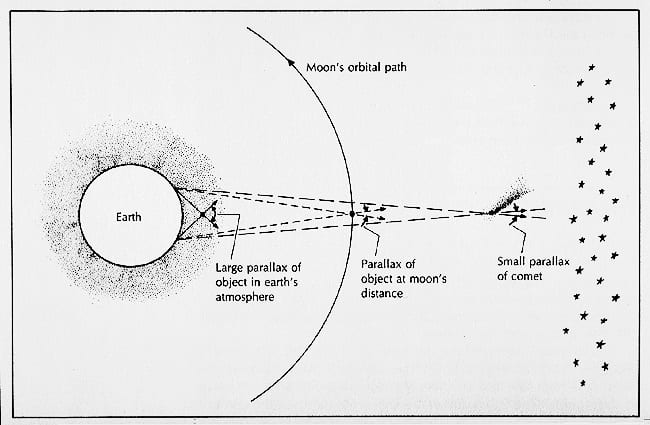
Ptolemy used to defend the fourth pillar by arguing, if the Earth is indeed moving, then, there has to be an apparent shift in the shapes of the constellations over the course of a year or so.
He used to put forward these two basic points.
- If a constellation does not appear to move at all, then the stars are much farther away from the sun and planets. Hence, their motion is undetectable.
- Or, maybe, in reality, Constellations (fixed stars) are not moving at all. Hence, the parallax motion does not exist.
As a result, somehow, only standing on its last pillar, the Earth-Centered Universe remained in the hearts of some astronomers until the discovery of stellar parallax.
Finally, in 1838, German astronomer Friedrich Bessel measured the parallax motion of star 61 Cygni. Therefore, broke the fourth and the last pillar of the Earth-Centered Universe.
By doing that, he put the fourth and final nail in the coffin of the geocentric model of the universe. And, the world knows, rest is history.
As a result, nowadays, the Aristotelian-Ptolemaic Model comes in the list of my top 6 obsolete cosmological models of the universe. I strongly recommend you to check it out.
Conclusion
Well, frankly speaking, I am not denying that without the help of Galileo, Kepler, Newton, and, Friedrich Bessel, the earth-centered universe could be wiped out from the heart and minds of the physicists and astronomers.
On the other hand, you should also not deny the fact that without the Copernican idea of the Sun-Centered Solar system, we still may be living in the dilemma of a geocentric universe, or, rather not.
Well, what’s your take on this? I mean, what do you think? Suppose, if the Copernican Revolution never took place, then, will we still believe in an earth-centered universe?
Or, someone else could have developed the Sun-Centered solar system. Enlighten me with your curiosity in the comment section.
That’s it for this post. If you like this article, share it if you like, like it if you share it. You can also find us on Mix, Twitter, Pinterest, and Facebook. Hey man, If you have come this far, do give us feedback in the comment section. It would make my day.

Hi Atul, I have a crowbar to remove the Four Nails. First, the Copernican model is simply the model of Aristarchus who modifed the model of Heraclides. Heraclides model of the rotating and revolving innermost concentric Earth was nearly perfect. Second, Galileo discovered that the planet Venus exhibited phases just as the Moon of Earth. So, this proved that both Venus and the Moon orbited the Earth. Third, Kepler should have factored in the revolution of the Earth in order to solve the puzzle of Mars. Fourth and final nail. The original model of Heraclides PREDICTS stellar parallax also. Blessings.